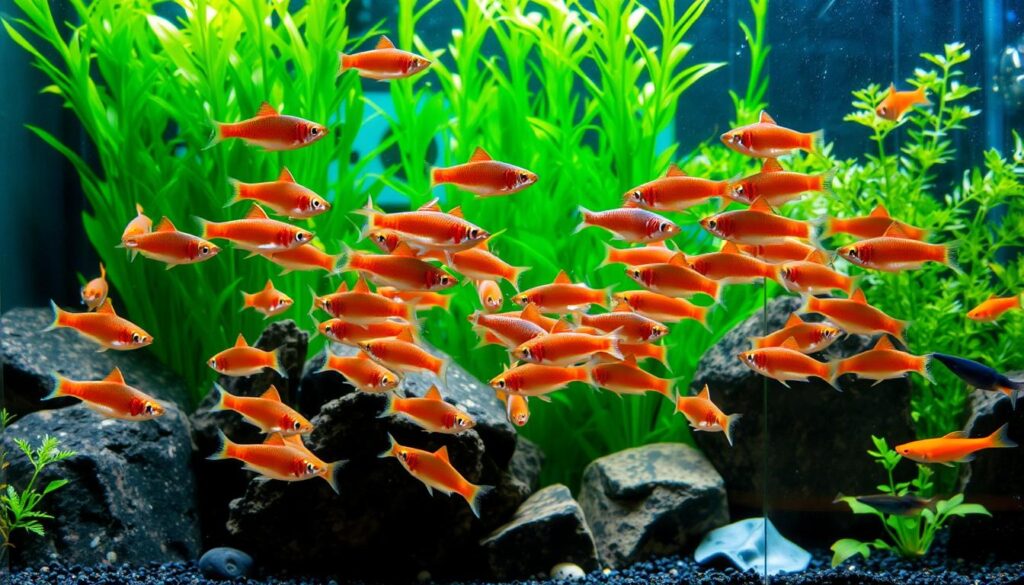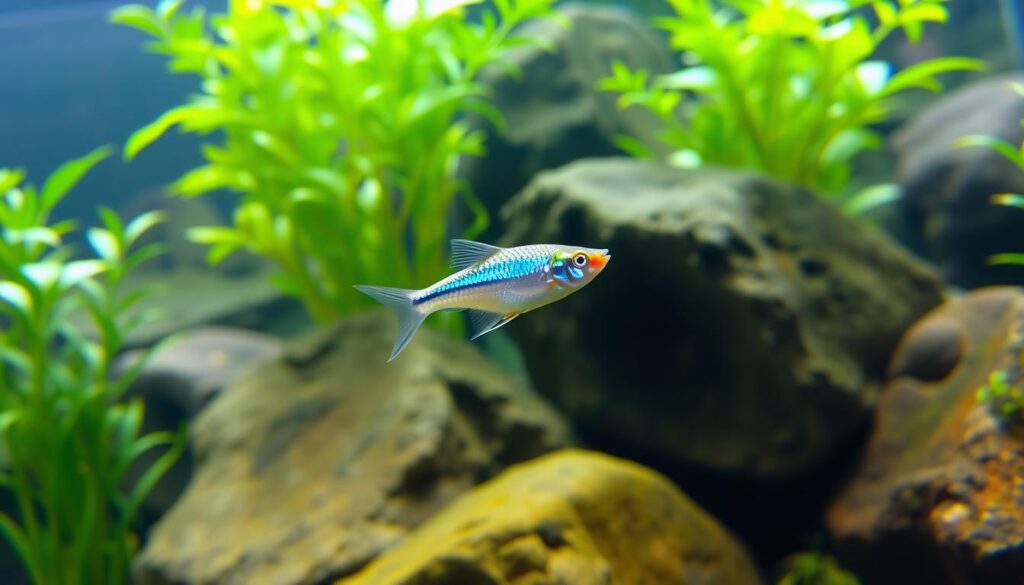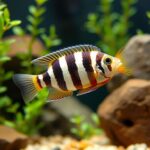Did you know the Rummy-Nose Tetra is a top choice among aquarium fish? This small fish, only 2 inches long, has won the hearts of many. It’s a favorite in home aquariums all over the world.
Rummy-Nose Tetras are loved for more than their looks. They swim together in schools, creating a beautiful sight. There are three main types of these fish sold: Hemigrammus rhodostomus, Hemigrammus bleheri, and Petitella georgiae.
These fish do well in warm water, making them easy to keep in many tanks. Their red face, silver body, and striped tail make them stand out. Watching them swim together is both beautiful and interesting.
Key Takeaways
- Rummy-Nose Tetras are among the top 20 most popular aquarium fish.
- They typically measure 2 inches (5 cm) in length.
- Three main species are sold as Rummy-Nose Tetras.
- They can live up to 5 years or more with proper care.
- A school of at least 8-12 Rummy-Nose Tetras is recommended.
- They prefer temperatures between 74-84°F (23-29°C).
- These fish are known for their unique coloration and tight schooling behavior.
Introduction to the Rummy-Nose Tetra
The Rummy-Nose Tetra is a fish that has captured the hearts of many aquarium lovers. Their unique look and behavior are truly captivating. These fish come from the Amazon basin, living in the blackwater rivers that wind through the rainforest.
Origin and Natural Habitat
Rummy-Nose Tetras live in the Amazon basin. They call blackwater rivers home, known for their dark waters. These rivers are full of tannins from decaying plants, making them acidic. Over time, these fish have adapted to this environment.
Physical Characteristics
Rummy-Nose Tetras stand out with their unique look. They have a torpedo-shaped body, ideal for fast swimming. Their bright red-orange snout is a key feature. The body is silver, and the tail has horizontal stripes in white and black. They usually grow to about 2 inches long.
Popularity in the Aquarium Hobby
Rummy-Nose Tetras are becoming more popular among aquarium keepers. Their bright colors and calm nature make them perfect for community tanks. They like to school, creating beautiful patterns as they move. With the right care, these fish can live for 6-8 years, adding joy to any aquarium.
| Characteristic | Description |
|---|---|
| Size | 1.5 – 2 inches |
| Lifespan | 6-8 years |
| Preferred pH | 5.5 – 7.0 |
| Temperature Range | 72°F – 82°F |
Species Variations and Identification
I love being an aquarist and have seen three main types of rummy-nose tetras. Each type has its own look, making it fun to tell them apart. Let’s dive into these interesting variations.
The true rummy-nose tetra, Hemigrammus rhodostomus, has a classic red nose and striped tail. Its relative, Hemigrammus bleheri, also known as the firehead or brilliant rummy-nose tetra, has more red on its head. Then there’s the false rummy-nose tetra, Petitella georgiae, which has a special middle black stripe on its tail.
Color variations are a big part of what makes these fish so attractive. While they’re already beautiful, albino and golden versions are now popular in aquariums. This adds more variety to the rummy-nose tetra group.
| Species | Common Name | Distinctive Features |
|---|---|---|
| Hemigrammus rhodostomus | True Rummy-Nose Tetra | Standard red nose, striped tail |
| Hemigrammus bleheri | Firehead Rummy-Nose Tetra | Extended red coloration past gill plate |
| Petitella georgiae | False Rummy-Nose Tetra | Middle black stripe on tail extending to body |
It can be hard to tell these species apart, but it’s important for their care. Look closely at the red color and the tail pattern. Paying attention to these details helps you give the best care to your rummy-nose tetras.
Behavior and Social Dynamics
Rummy-nose tetras are a hit with aquarium fans for their unique social ways. They show traits that make them stand out in the aquarium scene.
Schooling Behavior
Rummy-nose tetras are known for their tight schooling. They swim together in groups, creating a beautiful sight in the tank. This isn’t just for looks; it’s a way to stay safe.
By swimming together, they trick predators and boost their survival odds.
Studies reveal that light affects their swimming. In dim light, they move faster and shorter distances. But in bright light, they move longer and slower.
Interaction with Other Fish
Rummy-nose tetras are great for community tanks. They encourage shy fish to be more active. They’re calm, so they get along with many peaceful fish.
Watching them, it’s clear they help other fish feel more at ease. It’s amazing to see neon tetras and others join their school, making the tank lively.
Natural Stress Indicators
Rummy-nose tetras are also natural indicators of water quality. Their red noses fade when the water gets bad or if they’re stressed.
This trait makes them like “canaries in the coal mine” for aquarists. Watching their nose color helps me check my tank’s health.
| Behavior | Function | Benefit to Aquarist |
|---|---|---|
| Tight schooling | Predator confusion | Visual appeal |
| Dither fish role | Encourages shy fish | Balanced community tank |
| Nose color changes | Stress indication | Early warning system |
Optimal Tank Setup for Rummy-Nose Tetras
Creating the perfect home for rummy-nose tetras is key for their health and happiness. These lively fish do best in a setup that closely matches their natural habitat. Let’s explore the main elements of an ideal tank.
Tank Size and Layout
Rummy-nose tetras love to move around. So, they need a lot of space. I suggest a 20-gallon tank as a minimum for a small school. But, a bigger tank, like a 55-gallon or 75-gallon, is even better to see them fully enjoy their space.
In my 65-gallon high tank, 16 rummy-nose tetras swim happily. They have lots of room to explore.
Water Parameters
These tetras like soft, acidic water, just like their Amazon basin home. I keep the pH between 5.5 and 7.5 and the temperature between 74 to 84°F (23-29°C). It’s important to test the water often to keep it stable.
Substrate and Decoration
I use a dark substrate in my tank to make the tetras’ colors stand out. Adding driftwood, catappa leaves, and live plants makes the tank look beautiful and helps keep the water clean. This setup closely matches their natural environment, keeping my tetras stress-free and active.
| Tank Element | Recommendation |
|---|---|
| Tank Size | 20-gallon minimum, 55-75 gallon ideal |
| Water Temperature | 74-84°F (23-29°C) |
| pH Level | 5.5-7.5 |
| Substrate | Dark-colored, fine grain |
| Decor | Driftwood, catappa leaves, live plants |
A well-set-up tank looks great and helps your rummy-nose tetras live up to their 5-year lifespan. With the right setup, you’ll love watching these beautiful fish in your home aquarium.
Dietary Requirements and Feeding Habits
Rummy-Nose Tetras are interesting omnivores with unique eating habits. They love a varied diet, which keeps them healthy and lively. Watching them chase food in the tank is a delight.
To keep them happy, I feed them a mix of foods that fit their small mouths. Nano pellets, baby brine shrimp, and daphnia work great. Adding color-enhancing food to their diet makes their red noses pop and gives them important nutrients.
Here’s a breakdown of an ideal feeding schedule for Rummy-Nose Tetras:
| Meal | Food Type | Frequency |
|---|---|---|
| Staple | High-quality fish flakes or pellets | Daily |
| Supplement | Frozen or live foods (daphnia, bloodworms) | 2-3 times a week |
| Color Enhancer | Foods rich in carotenoids (krill, salmon) | 1-2 times a week |
Overfeeding can harm the water quality. I feed them small amounts they can eat in 2-3 minutes, 2-3 times a day. This way, they get the nutrients they need without dirtying their home.
Rummy-Nose Tetra Care and Maintenance
Caring for rummy-nose tetras means paying close attention and keeping up with maintenance. These fish are very popular, often in the top 20 at stores. So, it’s important to know how to take care of them.
Water Quality Management
Keeping the water clean is key for rummy-nose tetras. I change the water 20-30% every week to keep nitrates low. These fish do best in slightly acidic water with a pH of 5.5 to 7.0. They also like soft to moderately hard water, with a 2-6 KH level.

Health Monitoring
I keep a close eye on my rummy-nose tetras every day. Their nose color tells me a lot about their health. A bright red nose means they’re doing well, but a pale nose could mean stress or bad water.
When I add new fish, I use a separate tank first. This helps stop diseases from spreading.
Common Health Issues
Rummy-nose tetras can get ich and bacterial infections, especially when they first join the tank. I look out for white spots, odd swimming, or not eating. If I see any problems, I fix the water or use medicine as needed.
| Parameter | Ideal Range | Maintenance Action |
|---|---|---|
| Temperature | 75°F – 84°F (23.9°C – 28.9°C) | Use reliable heater |
| pH | 5.5 – 7.0 | Regular testing, adjust as needed |
| Ammonia/Nitrite | 0 ppm | Frequent water changes |
| Nitrate | <20 ppm | Weekly water changes |
By sticking to these care tips, I’ve kept my rummy-nose tetras healthy for 5-6 years. Remember, regular care and acting fast when needed are crucial for a happy aquarium.
Breeding Rummy-Nose Tetras in Captivity
Breeding rummy-nose tetras can be rewarding for aquarium fans. These egg scatterers need certain conditions to breed well in captivity. Setting up a proper breeding tank is key to their success.
Start with a 10-gallon tank just for breeding. The water should be soft and acidic, with a pH of 6.0 to 6.2. Keep the temperature between 82°F and 86°F to help them spawn. Use dense plants or spawning mops to protect the eggs.
Before breeding, feed the adults with high-quality live foods. Females will show a rounded belly, usually around 8 months to 1 year old. They lay 5 to 8 large eggs during spawning. After laying eggs, remove the adults to keep the eggs safe.
Fry Care
Caring for the fry is crucial for successful breeding. The eggs hatch in 24 to 36 hours. Start feeding them infusoria or powdered food, then switch to baby brine shrimp as they grow. Keeping the area lightly lit helps the eggs and fry.
| Breeding Parameter | Recommended Value |
|---|---|
| Tank Size | 10 gallons |
| Water Temperature | 82-86°F |
| pH Level | 6.0-6.2 |
| Water Hardness | 4-6 dGH |
| Egg Incubation Period | 24-36 hours |
With patience and the right care, you can breed these beautiful fish at home. Remember, keeping the water soft and acidic is vital for their breeding.
Compatibility with Other Aquarium Species
Rummy-nose tetras are great for community tanks. They are peaceful and get along with many other fish. They do best with fish of similar size and in warm water.
Ideal tank mates
Choosing the right friends for rummy-nose tetras is important. They are good with other tetras, rasboras, and corydoras. Peaceful dwarf cichlids also work well with them. I’ve seen them live happily with warm water fish like discus and German blue rams.

For the best group behavior, keep 8-10 schooling fish like corydoras or otocinclus catfish. This helps them interact naturally and lowers stress in the tank.
Species to avoid
Avoid big, aggressive fish or fin-nippers with rummy-nose tetras. Their fins are easy targets for bullies. Don’t mix them with fish that prefer cooler water, as they like it warm.
| Compatible Species | Incompatible Species |
|---|---|
| Other tetras | Large, aggressive fish |
| Rasboras | Fin-nippers |
| Corydoras | Cool water species |
| Peaceful dwarf cichlids | Territorial fish |
A 20-gallon planted aquarium is perfect for a small school of rummy-nose tetras. Keep the water warm, between 75°F to 82°F, and the pH level between 6.0 to 7.0. This ensures they stay healthy and happy with other tank mates.
Conclusion
Rummy-Nose Tetras are popular fish that add life and color to any tank. They form tight schools, creating a mesmerizing sight. These fish can live for 3 to 5 years and grow up to 2 inches long.
To keep them happy, I suggest a 15-gallon tank with a pH of 6.0 to 7.5. They like temperatures between 75°F and 82°F. Keeping them in groups of six or more helps them school naturally and reduces stress.
These fish are more than just pretty. They act as water quality indicators, making them useful for aquarists. With the right tank mates like Dwarf Cichlids or Corydoras catfish, they stand out as the centerpiece of a community tank. Their care is easy, and they look great, making them a great choice for all fish keepers.
FAQ
What is the origin of rummy-nose tetras?
What are the physical characteristics of rummy-nose tetras?
Why are rummy-nose tetras popular in the aquarium hobby?
What are the different species commonly sold as rummy-nose tetras?
What is the significance of the schooling behavior in rummy-nose tetras?
Why are rummy-nose tetras called the “canary in the coal mine” of aquariums?
What are the recommended tank requirements for rummy-nose tetras?
What are the dietary needs of rummy-nose tetras?
What are some common health issues and care requirements for rummy-nose tetras?
Is breeding rummy-nose tetras in captivity challenging?
What are suitable tank mates for rummy-nose tetras?
Source Links
- Care Guide for Rummy-Nose Tetras — Aquatic Canary in the Coal Mine
- Rummy-nose tetra
- Care Guide for Rummy Nose Tetra
- Rummy Nose Tetra – Care Guide
- Rummy Nose Tetra
- Care Guide for Rummy-Nose Tetras — Aquatic Canary in the Coal Mine
- Rummy Nose Tetra – Hemigrammus rhodostomus Fish Profile & Care Guide
- Kinematic analysis of social interactions deconstructs the evolved loss of schooling behavior in cavefish
- Tuning social interactions’ strength drives collective response to light intensity in schooling fish
- Care Guide for Rummy-Nose Tetras — Aquatic Canary in the Coal Mine
- Minimum tank size for rummynose school?
- 10 gallon ok for rummy nose tetras?
- Rummynose Tetra Care & Info – Maryland Aquarium Design, Installation, and Maintenance
- Rummy Nose Tetra 101: Diet, Tank Mates, Breeding & More
- Care Guide for Rummy-Nose Tetras — Aquatic Canary in the Coal Mine
- Care Guide for Rummy Nose Tetra
- Rummy Nose Tetra 101: Diet, Tank Mates, Breeding & More
- How To Breed Rummy Nose Tetras – What To Know | Hepper
- Rummy Nose Tetra: Profile, Aquarium Setup, Breeding – Tropical Fish and Aquariums
- Rummy Nose Tetra 101: Diet, Tank Mates, Breeding & More
- Classroom Tank Compatibility
- BRILLIANT RUMMY NOSE TETRA 3CM » Largest Freshwater Aquarium Store In Western Sydney
- Rummy Nose Tetra (Hemigrammus Bleheri)
- Rummy nose tetra
- Rummy Nose Tetra – Care, Tank Mates and Breeding Guide


